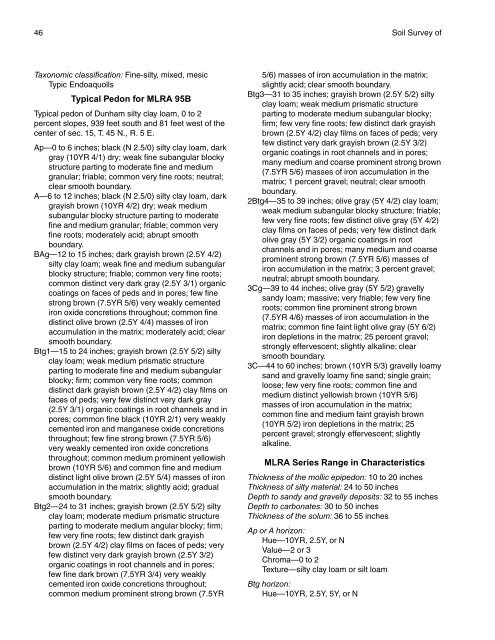Soil Survey of McHenry County, Illinois Part I - Soil Data Mart
Soil Survey of McHenry County, Illinois Part I - Soil Data Mart
Soil Survey of McHenry County, Illinois Part I - Soil Data Mart
You also want an ePaper? Increase the reach of your titles
YUMPU automatically turns print PDFs into web optimized ePapers that Google loves.
46 <strong>Soil</strong> <strong>Survey</strong> <strong>of</strong><br />
Taxonomic classification: Fine-silty, mixed, mesic<br />
Typic Endoaquolls<br />
Typical Pedon for MLRA 95B<br />
Typical pedon <strong>of</strong> Dunham silty clay loam, 0 to 2<br />
percent slopes, 939 feet south and 81 feet west <strong>of</strong> the<br />
center <strong>of</strong> sec. 15, T. 45 N., R. 5 E.<br />
Ap—0 to 6 inches; black (N 2.5/0) silty clay loam, dark<br />
gray (10YR 4/1) dry; weak fine subangular blocky<br />
structure parting to moderate fine and medium<br />
granular; friable; common very fine roots; neutral;<br />
clear smooth boundary.<br />
A—6 to 12 inches; black (N 2.5/0) silty clay loam, dark<br />
grayish brown (10YR 4/2) dry; weak medium<br />
subangular blocky structure parting to moderate<br />
fine and medium granular; friable; common very<br />
fine roots; moderately acid; abrupt smooth<br />
boundary.<br />
BAg—12 to 15 inches; dark grayish brown (2.5Y 4/2)<br />
silty clay loam; weak fine and medium subangular<br />
blocky structure; friable; common very fine roots;<br />
common distinct very dark gray (2.5Y 3/1) organic<br />
coatings on faces <strong>of</strong> peds and in pores; few fine<br />
strong brown (7.5YR 5/6) very weakly cemented<br />
iron oxide concretions throughout; common fine<br />
distinct olive brown (2.5Y 4/4) masses <strong>of</strong> iron<br />
accumulation in the matrix; moderately acid; clear<br />
smooth boundary.<br />
Btg1—15 to 24 inches; grayish brown (2.5Y 5/2) silty<br />
clay loam; weak medium prismatic structure<br />
parting to moderate fine and medium subangular<br />
blocky; firm; common very fine roots; common<br />
distinct dark grayish brown (2.5Y 4/2) clay films on<br />
faces <strong>of</strong> peds; very few distinct very dark gray<br />
(2.5Y 3/1) organic coatings in root channels and in<br />
pores; common fine black (10YR 2/1) very weakly<br />
cemented iron and manganese oxide concretions<br />
throughout; few fine strong brown (7.5YR 5/6)<br />
very weakly cemented iron oxide concretions<br />
throughout; common medium prominent yellowish<br />
brown (10YR 5/6) and common fine and medium<br />
distinct light olive brown (2.5Y 5/4) masses <strong>of</strong> iron<br />
accumulation in the matrix; slightly acid; gradual<br />
smooth boundary.<br />
Btg2—24 to 31 inches; grayish brown (2.5Y 5/2) silty<br />
clay loam; moderate medium prismatic structure<br />
parting to moderate medium angular blocky; firm;<br />
few very fine roots; few distinct dark grayish<br />
brown (2.5Y 4/2) clay films on faces <strong>of</strong> peds; very<br />
few distinct very dark grayish brown (2.5Y 3/2)<br />
organic coatings in root channels and in pores;<br />
few fine dark brown (7.5YR 3/4) very weakly<br />
cemented iron oxide concretions throughout;<br />
common medium prominent strong brown (7.5YR<br />
5/6) masses <strong>of</strong> iron accumulation in the matrix;<br />
slightly acid; clear smooth boundary.<br />
Btg3—31 to 35 inches; grayish brown (2.5Y 5/2) silty<br />
clay loam; weak medium prismatic structure<br />
parting to moderate medium subangular blocky;<br />
firm; few very fine roots; few distinct dark grayish<br />
brown (2.5Y 4/2) clay films on faces <strong>of</strong> peds; very<br />
few distinct very dark grayish brown (2.5Y 3/2)<br />
organic coatings in root channels and in pores;<br />
many medium and coarse prominent strong brown<br />
(7.5YR 5/6) masses <strong>of</strong> iron accumulation in the<br />
matrix; 1 percent gravel; neutral; clear smooth<br />
boundary.<br />
2Btg4—35 to 39 inches; olive gray (5Y 4/2) clay loam;<br />
weak medium subangular blocky structure; friable;<br />
few very fine roots; few distinct olive gray (5Y 4/2)<br />
clay films on faces <strong>of</strong> peds; very few distinct dark<br />
olive gray (5Y 3/2) organic coatings in root<br />
channels and in pores; many medium and coarse<br />
prominent strong brown (7.5YR 5/6) masses <strong>of</strong><br />
iron accumulation in the matrix; 3 percent gravel;<br />
neutral; abrupt smooth boundary.<br />
3Cg—39 to 44 inches; olive gray (5Y 5/2) gravelly<br />
sandy loam; massive; very friable; few very fine<br />
roots; common fine prominent strong brown<br />
(7.5YR 4/6) masses <strong>of</strong> iron accumulation in the<br />
matrix; common fine faint light olive gray (5Y 6/2)<br />
iron depletions in the matrix; 25 percent gravel;<br />
strongly effervescent; slightly alkaline; clear<br />
smooth boundary.<br />
3C—44 to 60 inches; brown (10YR 5/3) gravelly loamy<br />
sand and gravelly loamy fine sand; single grain;<br />
loose; few very fine roots; common fine and<br />
medium distinct yellowish brown (10YR 5/6)<br />
masses <strong>of</strong> iron accumulation in the matrix;<br />
common fine and medium faint grayish brown<br />
(10YR 5/2) iron depletions in the matrix; 25<br />
percent gravel; strongly effervescent; slightly<br />
alkaline.<br />
MLRA Series Range in Characteristics<br />
Thickness <strong>of</strong> the mollic epipedon: 10 to 20 inches<br />
Thickness <strong>of</strong> silty material: 24 to 50 inches<br />
Depth to sandy and gravelly deposits: 32 to 55 inches<br />
Depth to carbonates: 30 to 50 inches<br />
Thickness <strong>of</strong> the solum: 36 to 55 inches<br />
Ap or A horizon:<br />
Hue—10YR, 2.5Y, or N<br />
Value—2 or 3<br />
Chroma—0 to 2<br />
Texture—silty clay loam or silt loam<br />
Btg horizon:<br />
Hue—10YR, 2.5Y, 5Y, or N

















